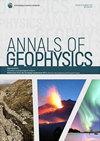2019年7月2日智利拉塞雷纳日全食期间气象参数的变化
IF 1.2
4区 地球科学
Q3 GEOCHEMISTRY & GEOPHYSICS
引用次数: 0
摘要
首份关于2019年7月2日智利拉塞雷纳日全食期间气象参数变化的报告。从新西兰东部、南太平洋的早晨到智利的日落时间,人们都可以观察到这一现象。利用La Serena气象站(29.827°S, 71.261°W, 28 masl)以1分钟时间分辨率记录了全球辐射Rg、净辐射Rn、反射辐射Rr (Wm-2 /min)、气温(TA℃)、相对湿度(RH %)、风速幅值(WS ms-1)和风速方向(WD度)等气象特性。重要的是,SER位于距离201公里宽的本影轴线40公里处,在晴朗的日子里,它以1.009等的亮度达到100%的黑暗。在这些有利条件下,我们观察到Rg、Rn和Rr的辐射分量下降率分别为3.1、2.4和0.5 (Wm-2 /min),日全食期间太阳表面辐射分量(0 Wm-2)下降率为100%。此外,与日食前一天相比,日食期间所有组件的能量损失约为34%。此外,TA -3.3°C、RH +11%、WS -1.11 ms-1、WD 180°~ 340°的变化率均与月球经过太阳完全同步,相对于日全食滞后约5 min达到峰值。因此,我们的结果表明,所有气象参数的渐进变化与月亮在太阳前面经过引起的月食相位完全同步。本文章由计算机程序翻译,如有差异,请以英文原文为准。
Changes in meteorological parameters during the total solar eclipse of 2 July 2019 in La Serena, Chile
The first report on the changes in meteorological parameters during the total solar eclipse of July 2, 2019, in La Serena (Chile), is presented. The event could be observed from morning time on the east of New Zealand, in the South Pacific Ocean, to sunset time in Chile. Several meteorological properties such as global radiation Rg, net radiation Rn, reflected radiation Rr (in Wm–2/min), air temperature (TA in °C), relative humidity (RH in %), wind speed amplitude (WS in ms–1), and wind speed direction (WD in degrees), were recorded with La Serena weather station SER (29.827°S, 71.261°W, 28 masl) at 1‑minute time resolution. Importantly, SER was located at 40 km from the axis of the umbra that covered 201 km of width, where it reached 100% darkness at a magnitude of 1.009 during a clear-sky day. Under these auspicious conditions, we observed a rate of changes in the drop of the radiation components of 3.1, 2.4, and 0.5 (Wm–2/min) for Rg, Rn, and Rr, respectively, with a 100% reduction in the components of surface solar radiation (0 Wm–2) during totality. In addition, all components showed a ~34% energy loss during the eclipse in comparison with the day before the event. Also, the rate of changes of –3.3 °C in TA, +11% in RH, –1.11 ms–1 in WS, and 180° to 340° for WD in total synchrony with the passing of the moon in front of the sun, reaching respective peaks at ~5 min lag with respect to totality. Thus, our results show a progressive change in all meteorological parameters in total synchrony with the eclipse’s phases caused by the passing of the moon in front of the sun.
求助全文
通过发布文献求助,成功后即可免费获取论文全文。
去求助
来源期刊

Annals of Geophysics
地学-地球化学与地球物理
CiteScore
2.40
自引率
0.00%
发文量
38
审稿时长
4-8 weeks
期刊介绍:
Annals of Geophysics is an international, peer-reviewed, open-access, online journal. Annals of Geophysics welcomes contributions on primary research on Seismology, Geodesy, Volcanology, Physics and Chemistry of the Earth, Oceanography and Climatology, Geomagnetism and Paleomagnetism, Geodynamics and Tectonophysics, Physics and Chemistry of the Atmosphere.
It provides:
-Open-access, freely accessible online (authors retain copyright)
-Fast publication times
-Peer review by expert, practicing researchers
-Free of charge publication
-Post-publication tools to indicate quality and impact
-Worldwide media coverage.
Annals of Geophysics is published by Istituto Nazionale di Geofisica e Vulcanologia (INGV), nonprofit public research institution.
 求助内容:
求助内容: 应助结果提醒方式:
应助结果提醒方式:


